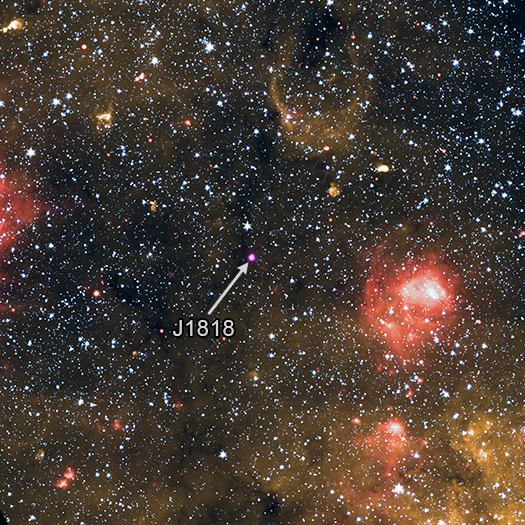In 2020, astronomers added a new member to an exclusive family of exotic objects with the discovery of a magnetar. New observations from NASA’s Chandra X-ray Observatory help support the idea that it is also a pulsar, meaning it emits regular pulses of light. This object, known as J1818.0-1607, is located about 21,000 light years away in the Milky Way galaxy and it is believed that is the fastest spinning and possibly the youngest magnetar known.

A magnetar is a type of neutron star believed to have an extremely powerful magnetic field. As for comparison, the strength of Earth’s magnetic field is 0.000032 T or this of a typical refrigerator magnet is 0.005 T. Also, the strength of the Large Hadron Collider (LHC) magnets is around 8 T, while the magnetic field strength required to levitate a frog (by diamagnetic levitation of the water in its body tissues) according to the 2000 Ig Nobel Prize in Physics is 16 T. Higher strengths of magnetic fields are observed in the Universe, such as a typical White dwarf star with an approximate magnetic field strength of 100 T. The magnetic strength range of the magnetar neutron stars (as in this case) range between 100 millions and 100 billions Tesla.
On March 12, 2020, astronomers detected a new magnetar with NASA’s Neil Gehrels Swift Telescope. This is only the 31st known magnetar, out of the approximately 3,000 known neutron stars. After follow-up observations, researchers determined that this object was special for other reasons. First, it may be the youngest known magnetar, with an age estimated to be about 500 years old and, secondly, it also spins faster than any previously discovered magnetar, rotating once around every 1.4 seconds.

Chandra’s observations of J1818.0-1607 gave astronomers the first high-resolution view of this object in X-rays. The Chandra data revealed a point source where the magnetar was located, which is surrounded by diffuse X-ray emission, likely caused by X-rays reflecting off dust located in its vicinity (Some of this diffuse X-ray emission may also be from winds blowing away from the neutron star.).
Other astronomers have also observed J1818.0-1607 with radio telescopes, such as the NSF’s Karl Jansky Very Large Array (VLA), and determined that it gives off radio waves. This implies that it also has properties similar to that of a typical “rotation-powered pulsar,” a type of neutron star that gives off beams of radiation that are detected as repeating pulses of emission as it rotates and slows down. Only five magnetars including this one have been recorded to also act like pulsars, constituting less than 0.2% of the known neutron star population.
The explosion that created a magnetar of this age would be expected to have left behind a detectable debris field. To search for this supernova remnant, astronomers looked at the X-rays from Chandra, infrared data from Spitzer, and the radio data from the VLA. Based on the Spitzer and VLA data they found possible evidence for a remnant, but at a relatively large distance away from the magnetar. In order to cover this distance the magnetar would need to have traveled at speeds far exceeding those of the fastest known neutron stars, even assuming it is much older than expected, which would allow more travel time.
A preprint of the Astrophysical Journal Letters paper by Blumer and Safi-Harb describing these results is available online. Source: chandra.harvard.edu
